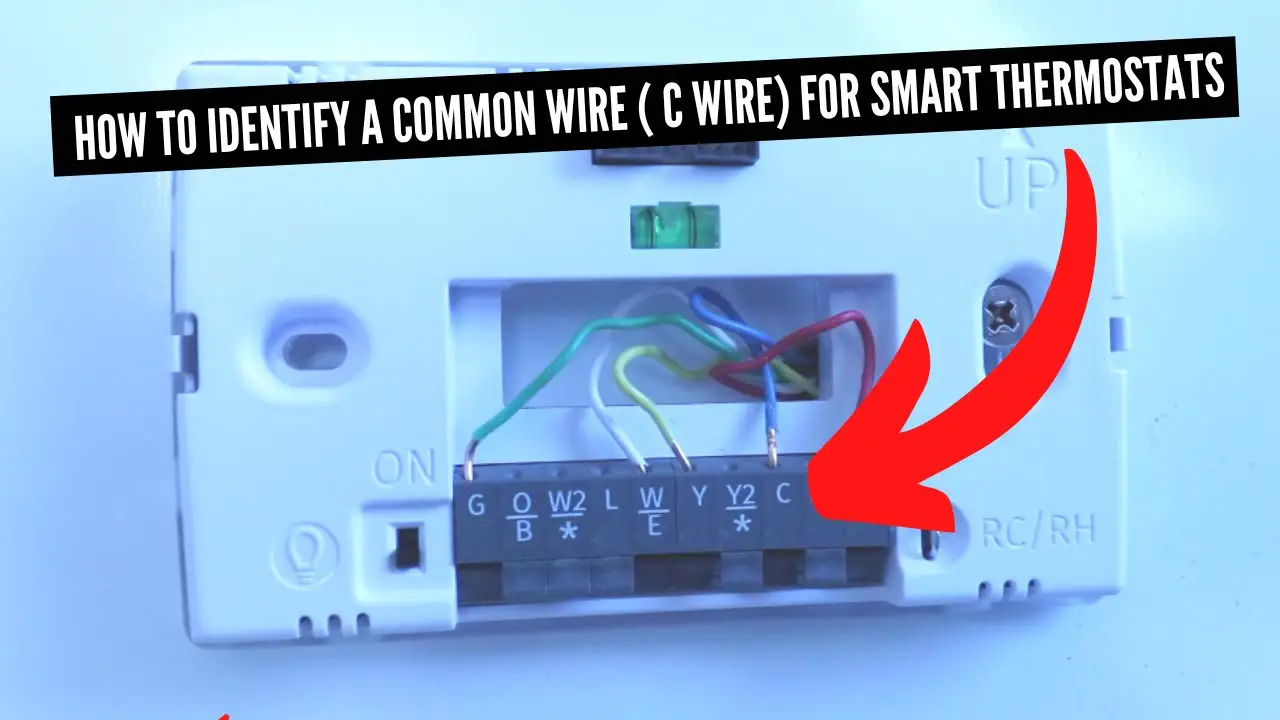Check Best Thermostat Pricing in Amazon
** As an Amazon Associate, I earn from qualifying purchases.
Have you ever found yourself puzzled by the maze of wires behind your thermostat? You’re not alone.
Many homeowners are confused by the term “common wire” or “C-wire” when dealing with their heating and cooling systems. It’s a small component, but it plays a crucial role in making sure your smart thermostat functions smoothly. Without it, you might miss out on the energy-saving features and convenience you desire.
Imagine never having to worry about manually adjusting your thermostat again, or enjoying a consistently comfortable home environment tailored to your schedule. Intrigued? Let’s unravel the mystery of the common wire and see how it can transform the way you experience comfort at home. Keep reading to discover why this unassuming wire is more important than you might think.
Common Wire Basics
Understanding the common wire in thermostats is essential for homeowners. This wire, often called the “C-wire,” plays a crucial role in modern thermostat systems. It provides continuous power to digital thermostats, helping maintain their advanced features. Knowing its function can simplify installation and troubleshooting.
What Is A Common Wire?
The common wire is an electrical wire. It connects the thermostat to the heating and cooling system. Its primary job is to supply power. This is especially important for smart thermostats. They need constant electricity to operate efficiently.
Why Do Thermostats Need A Common Wire?
Modern thermostats offer many features. They display weather forecasts and energy usage. These functions require constant power. The common wire ensures the thermostat is always on and ready. Without it, these features might not work.
Identifying the common wire can be tricky. Typically, it is blue or black. Sometimes, it is labeled with a “C.” It’s always a good idea to consult the thermostat’s manual. This helps ensure correct identification and connection.
A common wire offers many benefits. It supports advanced thermostat features. It also helps prevent battery replacement. With a common wire, thermostats run smoothly. This enhances the comfort and efficiency of your home.
Purpose Of The Common Wire
The common wire, or “C-wire,” is crucial in modern thermostats. It provides continuous power to the thermostat. This ensures the device remains functional and efficient. It is a key component for smart thermostats. They require more energy than older models. Understanding its purpose can help homeowners. It can also assist technicians in setting up a thermostat system.
Power Supply
The common wire ensures a constant power supply. This is essential for advanced thermostat features. Without it, smart thermostats may not work properly. These features include Wi-Fi connectivity and touchscreen displays. They demand a steady power flow. The C-wire helps prevent power interruptions.
Enhanced Functionality
Thermostats with a C-wire can offer enhanced functionality. They support features like energy usage reports and remote control. These features make managing home climates easier. They also help in reducing energy costs. A C-wire is often needed for these advanced capabilities.
Compatibility With Smart Technology
Smart homes rely on interconnected devices. The common wire helps thermostats integrate with smart home systems. It allows seamless control via apps and voice commands. This compatibility is crucial for modern living. It brings convenience and efficiency to everyday life.
Installation Considerations
Knowing the purpose of the common wire aids in installation. It helps in determining if your current setup supports a smart thermostat. If missing, professional installation might be required. Some thermostats offer solutions without a C-wire. Understanding these options can guide purchasing decisions.
Identifying The Common Wire
Understanding the common wire is crucial for thermostat wiring. It ensures your device gets continuous power. This wire is often called the “C” wire. It plays a key role in many modern thermostats.
Knowing how to identify this wire saves time and prevents errors. Let’s explore the ways to identify the common wire in your thermostat.
Color Codes
The common wire is often blue. But it can also be black. These colors help in easy identification. Always check your thermostat’s manual for specific wire colors. Different brands may use different colors.
Location In Thermostat
The common wire connects to the “C” terminal. This terminal is usually labeled. In most models, it is next to other terminals. Look for labels like “R,” “G,” and “W.” The “C” terminal is nearby.
If unsure, consult the thermostat’s wiring diagram. It shows wire locations and connections. This diagram is often on the thermostat cover.

Credit: linkdhome.com
Benefits Of Having A Common Wire
Understanding the benefits of a common wire in your thermostat can enhance your home’s energy efficiency. A common wire, often labeled as a ‘C-wire’, supplies consistent power to your thermostat. This wire plays a crucial role in ensuring optimal functionality. Many modern thermostats require a common wire for advanced features. Learn how a common wire can improve your thermostat’s performance and stability.
Enhanced Thermostat Functionality
A common wire allows your thermostat to maintain a steady power supply. This enables continuous use of Wi-Fi and smart features. Thermostats without a common wire might have limited capabilities. Features like remote control and learning schedules require constant power. A common wire ensures these functions run smoothly without interruptions.
Power Stability
Power stability is crucial for smart thermostats. A common wire provides this stability by offering a direct power source. Without it, thermostats may rely on batteries or power-stealing methods. These alternatives can be unreliable and cause performance issues. A constant power supply ensures your thermostat works efficiently at all times.
Check Best Thermostat Pricing in Amazon
** As an Amazon Associate, I earn from qualifying purchases.
Common Wire Installation
Installing a common wire, or “C wire,” can enhance your thermostat’s functionality. It’s vital for powering smart thermostats, which require consistent energy. Understanding the installation process ensures your device operates efficiently and saves energy. Let’s explore the tools needed and the step-by-step process.
Tools Needed
- Screwdriver
- Wire stripper
- Multimeter
- Drill
- Electrical tape
These tools help you safely install the common wire. Ensure you have them ready to avoid delays.
Step-by-step Process
- Turn off the power to your HVAC system. This prevents electric shocks.
- Remove the thermostat cover. Use a screwdriver to unscrew it.
- Identify the common wire terminal. It’s usually labeled “C.”
- Connect the common wire to the terminal. Use a wire stripper if needed.
- Secure the wire with electrical tape. This ensures it stays in place.
- Use a multimeter to test the connection. Verify the wire is live.
- Replace the thermostat cover. Ensure it’s secure and tight.
- Turn the power back on. Test your thermostat’s functionality.
Following these steps ensures a successful installation. It enhances your thermostat’s performance and reliability.
Troubleshooting Common Wire Issues
Experiencing issues with the common wire in your thermostat can be frustrating. The common wire, often labeled as the “C-wire,” provides continuous power to smart thermostats. It ensures all functions run smoothly. Problems with this wire can disrupt your thermostat’s performance. Understanding these issues helps resolve them quickly.
Common Problems
Several problems can affect the common wire. Loose connections are frequent culprits. These can cause intermittent power supply issues. Sometimes, the wire might be incorrectly connected. This can lead to the thermostat not working at all. Other times, the wire may be damaged. This results in power loss.
Some thermostats may not recognize the C-wire. This can happen due to compatibility issues. Identifying these problems early is crucial. It helps prevent larger issues later.
Fixing Connection Issues
Fixing connection issues starts with checking the wire. Ensure it is securely connected. A loose wire can create power interruptions. Tightening the connection may solve the problem.
If the wire is damaged, replacing it is necessary. Inspect the wire for visible damage. If you see frays or breaks, replace it. Use a compatible wire for your thermostat.
Ensure the thermostat is compatible with the common wire. Check the manufacturer’s guidelines. Sometimes, an adapter may be needed. This allows the thermostat to recognize the C-wire.
Alternatives To Common Wire
Thermostats often require a common wire for full functionality. Not all systems have this wire readily available. Homeowners face a challenge when installing modern thermostats without it. Luckily, there are alternatives to a common wire. These options provide solutions for those missing the common wire. Let’s explore some practical alternatives to ensure your thermostat works seamlessly.
Battery-powered Thermostats
Battery-powered thermostats offer a simple solution. They operate without a common wire. These thermostats use batteries to power the unit. It’s ideal for homes without a common wire. Installation is straightforward. Just set up the thermostat and insert batteries. Regular battery checks are necessary. It ensures the thermostat functions properly.
Using An Add-a-wire Kit
An Add-a-Wire kit is another option. It helps when your system lacks a common wire. This kit splits one wire into two. It creates a path for the common wire connection. Installation requires basic wiring skills. Follow the kit instructions carefully. The kit expands your current wiring setup. It allows your thermostat to operate efficiently.

Credit: www.reddit.com

Credit: www.cnet.com
Frequently Asked Questions
How Do I Find The Common Wire For My Thermostat?
Locate the C-wire by checking the thermostat’s wiring. It’s often blue, black, or labeled “C. ” Consult the thermostat manual for specific guidance. Use a multimeter to verify voltage. Ensure the HVAC system is off before inspecting. Seek professional help if unsure.
Do I Need A Common Wire For A Thermostat?
A common wire, or C-wire, is often needed for smart thermostats to provide continuous power. Traditional thermostats may not require it. Check your thermostat’s specifications to determine if a C-wire is necessary. If missing, you might need to install one or use a power adapter.
Which Wire Is The Common Wire?
The common wire is typically the neutral wire in electrical systems. It often appears white or gray. This wire carries current back to the power source, completing the circuit. Always confirm wire colors with a professional or refer to local electrical codes for accuracy.
How To Know If A C Wire Is Needed?
Check your thermostat’s manual or model online. Smart thermostats typically require a C wire. Without a C wire, power extenders or adapters might be necessary. Consult an electrician if unsure.
Conclusion
Understanding the common wire in a thermostat is important. It connects your system to power. This helps your thermostat work efficiently. Without it, smart features might not function. Many modern homes have this wire already. If not, consider an upgrade.
It can improve energy use. Remember, thermostats control your comfort. So, ensure yours is wired correctly. Always check your manual. Or consult a professional for guidance. This knowledge empowers better decisions. Keep your home comfortable year-round.
Check Best Thermostat Pricing in Amazon
** As an Amazon Associate, I earn from qualifying purchases.


